Summarize the knowledge points of Redis ordered set zset
This article brings you relevant knowledge about Redis, which mainly organizes the related issues of the ordered set zset. The redis ordered set zset is very similar to the ordinary set set. It is a set without Let’s take a look at the string collection of repeated elements. I hope it will be helpful to everyone.

Recommended learning: Redis video tutorial
redis ordered set zset is very similar to an ordinary set, it is a set without repeated elements collection of strings.
The difference is that each member of the ordered set is associated with a score, and this score is used to sort the members of the set from the lowest score
to the highest score.
The members of the collection are unique, but the ratings can be repeated.
Because the elements are ordered, you can quickly get a range of elements
based on score or position.
Accessing intermediate elements in an ordered set is also very fast, because you can use the ordered set as a smart column
table without duplicate members.
zadd: Add elements 
zrange: score ascending order, get the elements of the specified index range
Return stored in the ordered set key elements of the specified range. The returned elements can be thought of as being sorted by score from lowest to highest. If the scores are the same, they will be sorted lexicographically.
The subscript parameters start and stop are both base 0, that is to say, 0 represents the first member of the ordered set, 1 represents
the second member of the ordered set, and so on.
You can also use negative subscripts, with -1 representing the last member, -2 representing the second to last member, and so on.
zrange key 0 -1: All elements can be obtained
withscores: Return the member and its score value together, and the return list is expressed in the format of value1, score1, …, valueN, scoreN
Available versions:
= 1.2.0Time complexity:
O(log(N) M), N is the cardinality of the ordered set, and M is the cardinality of the result set.
Return value:
List of ordered set members with score value (optional) in the specified interval
zrevrange: score descending order, obtain the specified index range Element Returns the specified range of elements stored in the sorted collection key. The returned elements can be considered to be arranged from highest to lowest score
. If the scores are the same, they will be sorted by dictionary.
The subscript parameters start and stop are both base 0, that is to say, 0 represents the first member of the ordered set, 1 represents
the second member of the ordered set, and so on.
You can also use negative subscripts, with -1 representing the last member, -2 representing the second to last member, and so on.
withscores: Return the member and its score value together. The return list is expressed in the format of value1, score1, …, valueN, scoreN
zrangebyscore : Return data within the specified score range in ascending order by score
zincrby: Add the specified increment to the score of the specified element zrem: Delete multiple elements in the collection
zrem: Delete multiple elements in the collection 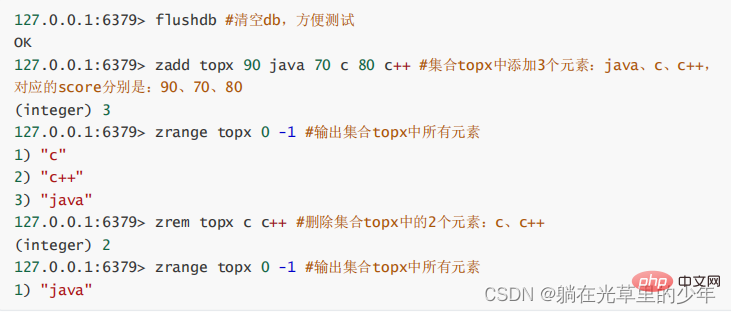
zremrangebyrank: Delete elements based on the index range 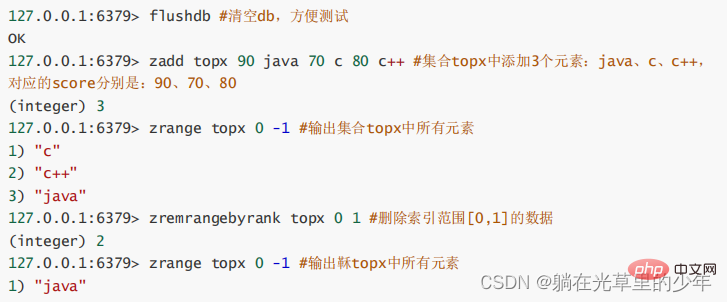
zremrangebyscore: Based on Delete elements from the range of score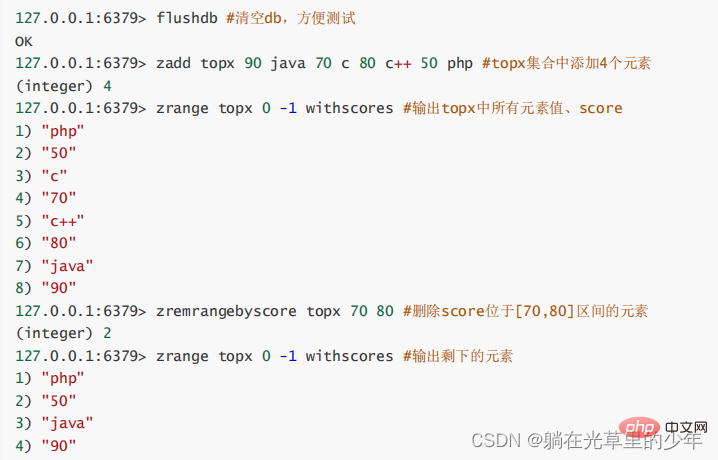
zcount: Count the number of elements within the specified score range
zrank: According to score Ascending order, returns the ranking of an element in the collection
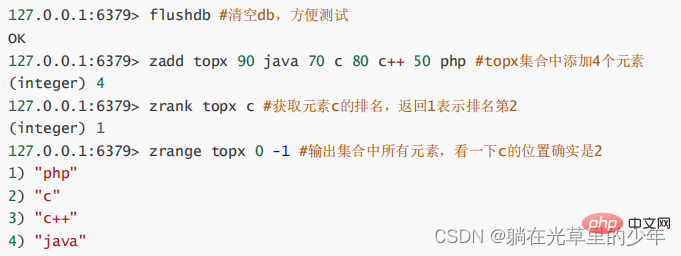
zrevrank: Returns the ranking of an element in the collection in descending order of score 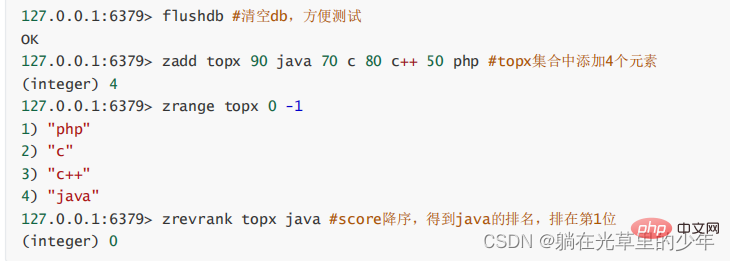
zscore: Returns the ranking of the specified element in the collection score
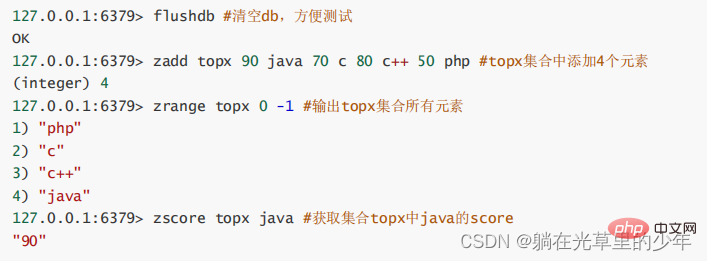
Data structure
SortedSet (zset) is a very special data structure provided by redis. Two data structures are used internally.
1. Hash table
is similar to Map
the element. The time complexity is O(1)
2. Skip list
The skip list is a very excellent data structure with simple implementation. The complexity of insertion, deletion and search is O(logN).
Similar to the ConcurrentSkipListSet in Java, a skip list is generated after sorting according to the score value. You can quickly query elements in the order of position
or the order of score.
Recommended learning: Redis video tutorial
The above is the detailed content of Summarize the knowledge points of Redis ordered set zset. For more information, please follow other related articles on the PHP Chinese website!

Hot AI Tools

Undresser.AI Undress
AI-powered app for creating realistic nude photos

AI Clothes Remover
Online AI tool for removing clothes from photos.

Undress AI Tool
Undress images for free

Clothoff.io
AI clothes remover

Video Face Swap
Swap faces in any video effortlessly with our completely free AI face swap tool!

Hot Article

Hot Tools

Notepad++7.3.1
Easy-to-use and free code editor

SublimeText3 Chinese version
Chinese version, very easy to use

Zend Studio 13.0.1
Powerful PHP integrated development environment

Dreamweaver CS6
Visual web development tools

SublimeText3 Mac version
God-level code editing software (SublimeText3)

Hot Topics
 1659
1659
 14
14
 1415
1415
 52
52
 1310
1310
 25
25
 1258
1258
 29
29
 1232
1232
 24
24
 How to build the redis cluster mode
Apr 10, 2025 pm 10:15 PM
How to build the redis cluster mode
Apr 10, 2025 pm 10:15 PM
Redis cluster mode deploys Redis instances to multiple servers through sharding, improving scalability and availability. The construction steps are as follows: Create odd Redis instances with different ports; Create 3 sentinel instances, monitor Redis instances and failover; configure sentinel configuration files, add monitoring Redis instance information and failover settings; configure Redis instance configuration files, enable cluster mode and specify the cluster information file path; create nodes.conf file, containing information of each Redis instance; start the cluster, execute the create command to create a cluster and specify the number of replicas; log in to the cluster to execute the CLUSTER INFO command to verify the cluster status; make
 How to clear redis data
Apr 10, 2025 pm 10:06 PM
How to clear redis data
Apr 10, 2025 pm 10:06 PM
How to clear Redis data: Use the FLUSHALL command to clear all key values. Use the FLUSHDB command to clear the key value of the currently selected database. Use SELECT to switch databases, and then use FLUSHDB to clear multiple databases. Use the DEL command to delete a specific key. Use the redis-cli tool to clear the data.
 How to read redis queue
Apr 10, 2025 pm 10:12 PM
How to read redis queue
Apr 10, 2025 pm 10:12 PM
To read a queue from Redis, you need to get the queue name, read the elements using the LPOP command, and process the empty queue. The specific steps are as follows: Get the queue name: name it with the prefix of "queue:" such as "queue:my-queue". Use the LPOP command: Eject the element from the head of the queue and return its value, such as LPOP queue:my-queue. Processing empty queues: If the queue is empty, LPOP returns nil, and you can check whether the queue exists before reading the element.
 How to configure Lua script execution time in centos redis
Apr 14, 2025 pm 02:12 PM
How to configure Lua script execution time in centos redis
Apr 14, 2025 pm 02:12 PM
On CentOS systems, you can limit the execution time of Lua scripts by modifying Redis configuration files or using Redis commands to prevent malicious scripts from consuming too much resources. Method 1: Modify the Redis configuration file and locate the Redis configuration file: The Redis configuration file is usually located in /etc/redis/redis.conf. Edit configuration file: Open the configuration file using a text editor (such as vi or nano): sudovi/etc/redis/redis.conf Set the Lua script execution time limit: Add or modify the following lines in the configuration file to set the maximum execution time of the Lua script (unit: milliseconds)
 How to use the redis command line
Apr 10, 2025 pm 10:18 PM
How to use the redis command line
Apr 10, 2025 pm 10:18 PM
Use the Redis command line tool (redis-cli) to manage and operate Redis through the following steps: Connect to the server, specify the address and port. Send commands to the server using the command name and parameters. Use the HELP command to view help information for a specific command. Use the QUIT command to exit the command line tool.
 How to implement redis counter
Apr 10, 2025 pm 10:21 PM
How to implement redis counter
Apr 10, 2025 pm 10:21 PM
Redis counter is a mechanism that uses Redis key-value pair storage to implement counting operations, including the following steps: creating counter keys, increasing counts, decreasing counts, resetting counts, and obtaining counts. The advantages of Redis counters include fast speed, high concurrency, durability and simplicity and ease of use. It can be used in scenarios such as user access counting, real-time metric tracking, game scores and rankings, and order processing counting.
 How to set the redis expiration policy
Apr 10, 2025 pm 10:03 PM
How to set the redis expiration policy
Apr 10, 2025 pm 10:03 PM
There are two types of Redis data expiration strategies: periodic deletion: periodic scan to delete the expired key, which can be set through expired-time-cap-remove-count and expired-time-cap-remove-delay parameters. Lazy Deletion: Check for deletion expired keys only when keys are read or written. They can be set through lazyfree-lazy-eviction, lazyfree-lazy-expire, lazyfree-lazy-user-del parameters.
 How to optimize the performance of debian readdir
Apr 13, 2025 am 08:48 AM
How to optimize the performance of debian readdir
Apr 13, 2025 am 08:48 AM
In Debian systems, readdir system calls are used to read directory contents. If its performance is not good, try the following optimization strategy: Simplify the number of directory files: Split large directories into multiple small directories as much as possible, reducing the number of items processed per readdir call. Enable directory content caching: build a cache mechanism, update the cache regularly or when directory content changes, and reduce frequent calls to readdir. Memory caches (such as Memcached or Redis) or local caches (such as files or databases) can be considered. Adopt efficient data structure: If you implement directory traversal by yourself, select more efficient data structures (such as hash tables instead of linear search) to store and access directory information






